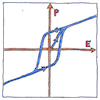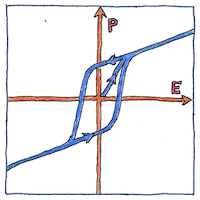Joseph Valasek
electromagnetism

|
Ferroelectricity
A ferroelectric material is like a ferromagnetic material except that a ferromagnetic material has a magnetic polarization, whereas a ferroelectric material has a electric polarisation. Because ferroelectricity can be controlled by an external electric field, ferroelectric material make tunable capacitors. Because hysteresis occurs in ferroelectric materials, they make random access memory for computers and RFID cards.
What to name it
Erwin Schrödinger thought it should exist and coined the term. Although his report didn’t use Schrödinger’s term, Joseph Valasek discovered it in Rochelle salt. Ferroelectricity is a odd term for the effect because the prefix ferro means iron and ferroelectric materials do not contain iron.
Related to
Ferroelectric materials are pyroelectric; not all pyroelectric materials are ferroelectric. Pyroelectric materials are piezoelectric; not all piezoelectric materials are pyroelectric. If it’s not piezoelectric, then it’s not pyroelectric, and if it’s not pyroelectric, then it’s not ferroelectric.



Pierre and Elie Seignette in La Rochelle first made Rochelle salt around 1665. For this reason, it was proposed to rename ferroelectricity to “Seignette-electricity,” but “ferroelectricity” sounds much better.
See also in The book of science:
Readings in wikipedia:
Other readings: